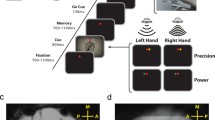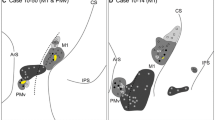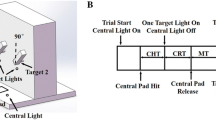Summary
Single neurons were recorded from the rostral part of the agranular frontal cortex (area 6aβ) in awake, partially restrained macaque monkeys. In the medialmost and mesial sectors of this area, rostral to the supplementary motor area, neurons were found which were activated during arm reaching-grasping movements. These neurons (“reaching-grasping neurons”) did not appear to be influenced by how the objects were grasped nor, with some exceptions, by where they were located. Their activity changed largely prior to the arm movement and continued until the end of it. The premovement modulation (excitatory or inhibitory) could start with stimulus presentation, with the saccade triggered by the stimulus or after stimulus fixation. The distance of the stimulus from the monkey was an important variable for activating many neurons. About half of the recorded neurons showed a modulation of the same sign during movement and premovement period. The other half showed an increase/decrease in activity which was of the opposite sign during movement and premovement period or part of it. In this last case the discharge changes were of the same sign when the stimulus was close to the monkey and when the monkey moved its arm to reach the objects, whereas they were of opposite sign when the stimulus was outside the animal's reach. Microstimulation of area 6aβ and the reconstruction of the locations of eye movement and arm movement related cells showed that the arm field was located more medially (and mesially) than the eye field described by Schlag and Schlag-Rey (1987). It is suggested that, unlike inferior area 6, which is mostly involved in selection of effectors on the basis of the physical properties of the objects and their spatial location (Rizzolatti and Gentilucci 1988), area 6aβ plays a role in the preparation of reaching-grasping arm movements and in their release when the appropriate conditions are set.
Similar content being viewed by others
References
Brinkman C, Porter R (1979) Supplementary motor area in the monkey: activity of neurons during performance of a learned motor task. J Neurophysiol 42: 681–709
Eccles JC (1982) The initiation of voluntary movements by the supplementary motor area. Arch Psychiatr Nervenkr 231: 423–431
Ferrigno G, Pedotti A (1985) ELITE: a digital dedicated hardware system for movement analysis via real-time TV-signal processing. IEEE Trans Biomed Eng BME 32: 943–950
Gentilucci M, Fogassi L, Luppino G, Matelli M, Camarda RM, Rizzolatti G (1988) Functional organization of inferior area 6 in the macaque monkey. I. Somatotopy and the control of proximal movements. Exp Brain Res 71: 475–490
Gentilucci M, Scandolara C, Pigarev IN, Rizzolatti G (1983) Visual responses in the postarcuate cortex (area 6) of the monkey that are independent of eye position. Exp Brain Res 50: 464–468
Godschalk M, Lemon RN, Nijs HGT, Kuypers HGJM (1981) Behavior of neurons in monkey peri-arcuate and precentral cortex before and during visually guided arm and hand movements. Exp Brain Res 44: 113–116
Goldberg G (1985) Supplementary motor area structure and function: review and hypotheses. Behav Brain Sci 8: 567–616
Halsband U, Passingham R (1982) The role of premotor and parietal cortex in the direction of action. Brain Res 240: 368–372
Humphrey DR (1979) On the cortical control of visually directed reaching: contributions by non-precentral motor areas. In: Talbot RE, Humphrey DR (eds) Posture and movement. Raven Press, New York, pp 51–112
Hyvärinen J (1982) Posterior parietal lobe of the primate brain. Physiol Rev 62: 1060–1129
Judge SJ, Richmond BJ, Chu FC (1980) Implantation of magnetic search coils for measurement of eye position: an improved method. Vision Res 20: 535–538
Kurata K, Tanji J (1986) Premotor cortex neurons in macaques: activity before distal and proximal forelimb movements. J Neurosci 6: 403–411
Kurata K, Wise SP (1988a) Premotor cortex of rhesus monkeys: set-related activity during two conditional motor tasks. Exp Brain Res 69: 327–343
Kurata K, Wise SP (1988b) Premotor and supplementary motor cortex in rhesus monkeys: neuronal activity during externally-and internally-instructed motor tasks. Exp Brain Res 72: 237–248
Kuypers HGJM (1981) Anatomy of the descending pathways. In. Brooks VB (ed) Handbook of Physiology, Vol II. Motor control, Part 1. American Physiological Society, Bethesda, MD pp 597–666
Macpherson JM, Marangoz C, Miles TS, Wiesendanger M (1982) Microstimulation of the supplementary motor area (SMA) in the awake monkey. Exp Brain Res 45: 410–416
Mann SE, Thau R, Schiller PH (1988) Conditional task-related responses in monkey dorsomedial frontal cortex. Exp Brain Res 69: 460–468
Matelli M, Luppino G, Rizzolatti G (1985) Patterns of cytochrome oxidase activity in the frontal agranular cortex of macaque monkey. Behav Brain Res 18: 125–137
Matelli M, Camarda RM, Glickstein M, Rizzolatti G (1986) Afferent and efferent projections of the inferior area 6 in the macaque monkey. J Comp Neurol 251: 281–298
Matsumura M, Kubota K (1979) Cortical projection of hand-arm motor area from postarcuate area in macaque monkey: a histological study of retrograde transport of horseradish peroxidase. Neurosci Lett 11: 241–246
Mitz AR, Wise SP (1987) The somatotopic organization of the supplementary motor area: intracortical microstimulation mapping. J Neurosci 7: 1010–1021
Moll L, Kuypers HGJM (1977) Premotor cortical ablation in monkeys: contralateral changes in visually guided reaching behavior. Science 198: 317–319
Muakkassa KF, Strick PL (1979) Frontal lobe inputs to primate motor cortex: evidence for four somatotopically organized ‘premotor’ areas. Brain Res 177: 176–182
Okano K, Tanji J (1987) Neuronal activities in the primate motor fields of the agranular frontal cortex preceding visually triggered and self-paced movement. Exp Brain Res 66: 155–166
Passingham RE (1987) Two cortical systems for directing movements. Ciba Foundation Symp 122: 151–164
Petrides M (1982) Motor conditional associative-learning after selective prefrontal lesions in the monkey. Behav Brain Res 5: 407–413
Rizzolatti G (1985) Free will and motor subroutines: too much for a small area. Behav Brain Sci 8:4: 597
Rizzolatti G, Gentilucci M (1988) Motor and visual-motor functions of the premotor cortex. In: Rakic P, Singer W (eds) Neurobiology of neocortex. Dahlem Konferenzen. Wiley, Chichester, pp 269–284
Rizzolatti G, Camarda RM, Fogassi L, Gentilucci M, Luppino G, Matelli M (1988) Functional organization of inferior area 6 in the macaque monkey. II. Area F5 and the control of distal movements. Exp Brain Res 71: 491–507
Rizzolatti G, Matelli M, Pavesi G (1983) Deficits in attention and movement following the removal of postarcuate (area 6) and prearcuate (area 8) cortex in macaque monkeys. Brain 106: 655–673
Rizzolatti G, Scandolara C, Gentilucci M, Camarda RM (1981a) Response properties and behavioural modulation of “mouth” neurons of the postarcuate cortex (area 6) in macaque monkey. Brain Res 255: 421–424
Rizzolatti G, Scandolara C, Matelli M, Gentilucci M (1981b) Afferent properties of periarcuate neurons in macaque monkey. I. Somato-sensory responses. Behav Brain Res 2: 125–146
Rizzolatti G, Scandolara C, Matelli M, Gentilucci M (1981c) Afferent properties of periarcuate neurons in macaque monkey. II. Visual responses. Behav Brain Res 2: 147–163
Robinson DA (1963) A method of measuring eye movements using a scleral search coil in a magnetic field. IEEE Trans Biomed Eng 10: 137–145
Roland PE, Larsen NA, Shinhoj E (1980) Supplementary motor area and other cortical areas in organization of voluntary movements in man. J Neurophysiol 43: 118–136
Roland PE, Meyer E, Shibasaki T, Yamamoto YL, Thompson C (1982) Regional cerebral blood flow changes in cortex and basal ganglia during voluntary movements in normal human volunteers. J Neurophysiol 48: 467–480
Schlag J, Schlag-Rey M (1987) Evidence for a supplementary eye field. J Neurophysiol 57: 179–200
Tanji J (1984) The neuronal activity in the supplementary motor area of primates. Trends Neurosci 7: 282–285
Tanji J, Kurata K (1985) Contrasting neuronal activity in supplementary and precentral motor cortex of monkeys. 1. Responses to instructions determining motor responses to forthcoming signals of different modalities. J Neurophysiol 53: 129–141
Vogt O, Vogt C (1919) Ergebnisse unserer Hirnforschung. J Psychol Neurol (Leipzig) 25: 277–462
Weinrich M, Wise SP (1982) The premotor cortex of the monkey. J Neurosci 2: 1329–1344
Weinrich M, Wise SP, Mauritz KH (1984) A neurophysiological study of the premotor cortex in the rhesus monkey. Brain 107: 385–414
Wiesendanger M, Hummelsheim H, Bianchetti M, Chen DF, Hyland B, Maier V, Wiesendanger R (1987) Input and output organization of the supplementary motor area. Discussion. Ciba Foundation Symposium 132: 53–62
Wise SP, Mauritz KH (1985) Set-related neuronal activity in the premotor cortex of rhesus monkeys: effects of changes in motor set. Proc R Soc LB 223: 331–354
Wise SP (1985) The primate premotor cortex: past, present and preparatory. Ann Rev Neurosci 8: 1–19
Woolsey CN, Settlage PH, Meyer DR, Sencer W, Pinto Hamuy T, Travis AM (1952) Patterns of localization in precentral and “supplementary” motor areas and their relation to the concept of a premotor area. Res Publ Assoc Res Nerv Ment Dis 30: 238–264
Author information
Authors and Affiliations
Rights and permissions
About this article
Cite this article
Rizzolatti, G., Gentilucci, M., Camarda, R.M. et al. Neurons related to reaching-grasping arm movements in the rostral part of area 6 (area 6aβ). Exp Brain Res 82, 337–350 (1990). https://doi.org/10.1007/BF00231253
Received:
Accepted:
Issue Date:
DOI: https://doi.org/10.1007/BF00231253




